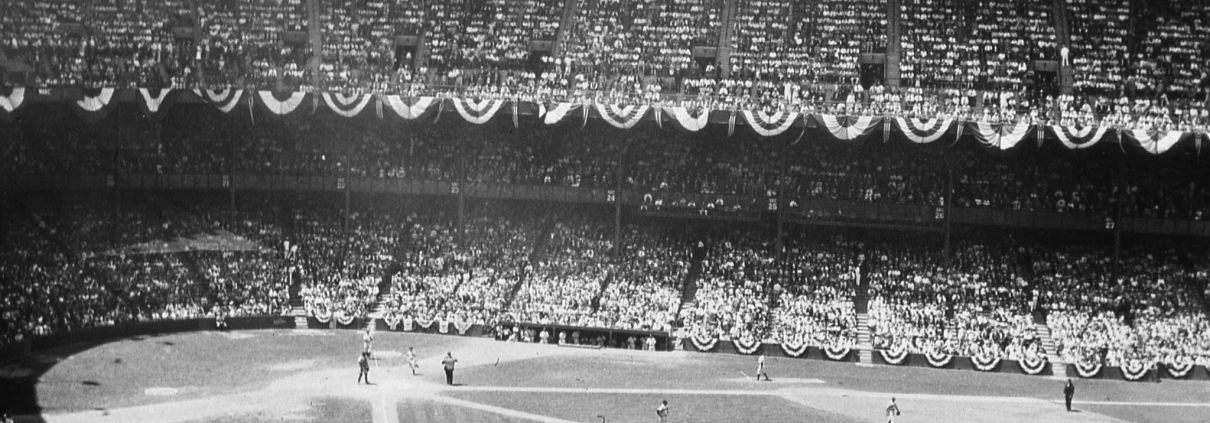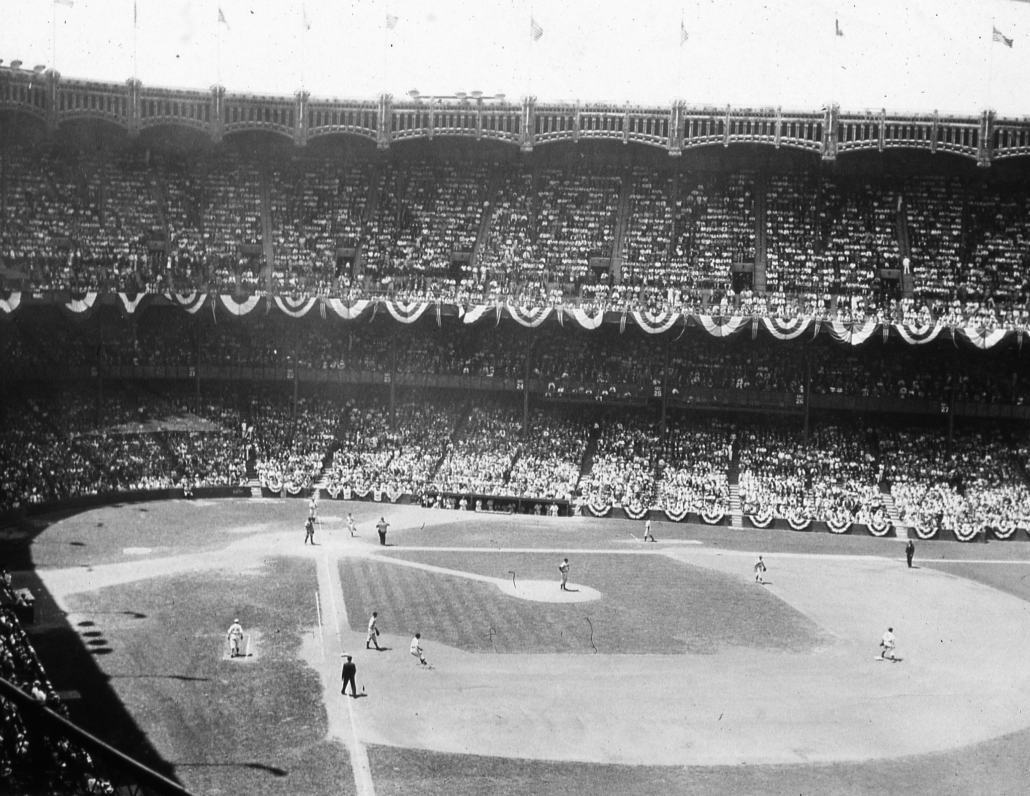July 11, 1939: Yankees dominate, but an Indian saves the day in first Bronx All-Star Game
Yankee Stadium was the natural choice to hold the All-Star Game in 1939. The game originated in Chicago in 1933, as an activity adjacent to the city’s Century of Progress World’s Fair. Six years later, New York was home to another World’s Fair, touting “The World of Tomorrow.” Companies like Westinghouse and National Cash Register showed off their newest, state-of-the-art products, and industrial engineer Norman Bel Geddes touted his Futurama, a city from the far-off future in 1960, a world where elevated highways and transcontinental flights were not just possible but part of everyday life.1 Even baseball got into the act, with an Academy of Sport at the fair. In anticipation of the fair, Uniforms for New York City’s three teams, the Brooklyn Dodgers, New York Giants, and New York Yankees, included a minimalist patch with the Fair’s logo of the Trylon and Perisphere buildings in 1938.2
Because of the opportunity to showcase the city, Yankee Stadium was picked to host the 1939 midseason classic, just five years after the Polo Grounds hosted the second All-Star Game, in 1934.3 It was the second newest venue in baseball (only the Indians’ part-time home, Cleveland Stadium, had been built more recently, opening in 1931), but it was the culmination of an early ballpark-building boom, as steel and concrete edifices supplanted rickety wood structures.
As the most ostentatious new ballpark in America’s biggest city, Yankee Stadium almost immediately became the center of the sports universe. It hosted prizefights. It hosted football games. And because its opening came not long after the debut of Babe Ruth as a Yankee – and the same year another Yankee legend, Lou Gehrig, made his major-league debut – it became home to a lot of championship teams. The Yankees won their first World Series in 1923, the year the stadium opened, and six more before the 1939 season, including the previous three.
By then, the tradition was in place that the managers of the previous year’s World Series teams would manage the All-Star squads. The Cubs’ Gabby Hartnett led the National League squad, but because it was the “centennial” year for baseball,4 Athletics manager Connie Mack, an inductee into the National Baseball Hall of Fame that had opened earlier that summer in Cooperstown, New York, was chosen as the American League manager.5 Ultimately, Mack begged off due to health issues, and the job fell back to Joe McCarthy, who’d managed each of the previous three All-Star squads.6
Ticket prices were the same for the All-Star Game as for any other Yankees game,7 which seemed appropriate; in many ways, it was a Yankees home game. McCarthy managed, and his coaching staff included Art Fletcher, who served as assistant to McCarthy as well as his predecessor, Miller Huggins. And no fewer than nine Yankees were named to the American League team, which made sense, given that the team was out to so far a lead that New York oddsmaker Jack Doyle had considered it a foregone conclusion that they’d win the pennant, offering odds only on who would finish second.8
Gehrig was one of the Yankees named to the American League team (he’d been named to the previous six as well), but he would not be playing. In fact, his retirement was announced the month before, and just a week before the All-Star Game, he was honored between games of an Independence Day doubleheader at the Stadium, telling fans, “Today, I consider myself the luckiest man on the face of the earth.”
Gehrig delivered the American League lineup card to the umpires and received the loudest cheers of the day. It was one of his final appearances in a Yankees uniform, and his ailment was noticeable. “Gehrig walks with a distinct limp,” said Cleveland Plain Dealer sports editor Gordon Cobbledick. “It is not the limp of an injured athlete. It is the halting, jerky limp of a cripple.”9
The only non-Yankees in the starting lineup were the Tigers’ Hank Greenberg, replacing Gehrig at first base, and Red Sox shortstop Joe Cronin and right fielder Doc Cramer. Red Rolfe started at third base, Joe DiMaggio was in center field, George Selkirk was in left field, Joe Gordon was at second, and Red Ruffing was pitching to Bill Dickey.10
Scoring started in the top of the third. Pirates shortstop Arky Vaughan led off the inning and singled for the National Leaguers. Paul Derringer hit two foul balls in an effort to sacrifice and advance Vaughan, but struck out swinging. Stan Hack hit a bloop that fell in in shallow left field to advance Vaughan to second. Lonny Frey then hammered a double over first base into right field, scoring Vaughan. Ival Goodman was intentionally walked to load the bases. Frank McCormick struck out on three pitches, and Ernie Lombardi flied out to end the threat.
In the bottom of the fourth, Derringer had been relieved by Cubs pitcher Bill Lee.11 With two on and two out, Selkirk hit a ball to right field. Goodman laid out but couldn’t make the catch, and Dickey scored to even up the game. The next batter, Gordon, hit a line drive to Vaughan, which he muffed, allowing Greenberg to score. Tommy Bridges struck out looking to end the inning. In the bottom of the fifth, the American League added an insurance run when DiMaggio hit a towering home run to left field with two outs.
The American Leaguers found themselves in a bind in the sixth inning. McCormick led off the frame with a groundout to Gordon. Lombardi singled to left-center on the very next pitch. Joe Medwick hit a roller to Cronin, who was too eager to turn a double play on the slow-footed Lombardi. Cronin booted the ball, leaving Medwick and Lombardi on first and second. Mel Ott hit a single that was batted down just past the infield dirt by Gordon, keeping a run from scoring.
In the Yankee Stadium bullpen, Bob Feller was warming up. He was planning to relieve Bridges in the seventh, but McCarthy called him in earlier. Not yet 21, the Indians pitcher had already shown himself to be one of the supreme hurlers of the day. Indeed, this was already his second All-Star Game appearance. And he was going to bring the heat.
“The best thing I could do was come overhand and throw him a fastball, which I did,” Feller recalled in a 2008 interview.12 And Vaughan hit it right to Gordon, who shoveled it to Cronin for the force at second. Cronin then fired to Greenberg for the double play to get out of the jam.
Feller dominated the rest of the way, earning the save. The first batter of the seventh inning, Babe Phelps, who pinch-hit for Lee, took a pitch – and demanded to see the ball, believing it was doctored!13 Vaughan had one more chance at Feller, in the ninth inning with Ott on first, but he popped out to DiMaggio.
“It is no trick whatever to pick out the All-Star goat,” Tommy Holmes wrote in the next day’s Brooklyn Eagle. It was Arky Vaughan. “This was the first time the Pittsburgh shortstop ever saw the Yankee Stadium. He’ll see it in a hundred nightmares from now on.”14
Feller struck out pinch-hitter Johnny Mize with a curveball that “looked like an aspirin tablet that rolled off a table,”15 and with a full count, struck out Hack looking to end the game.16
“Nice work all around, fellers,” McCarthy said after the game. “It was a good ball game. We got our share of the breaks and capitalized on them.”17
Sources
In addition to the sources cited in the Notes, the author consulted Baseball-Reference.com and Retrosheet.org for pertinent information, including box scores.
https://www.baseball-reference.com/allstar/1939-allstar-game.shtml
https://www.retrosheet.org/boxesetc/1939/B07110ALS1939.htm
Photo credit: SABR-Rucker Archive.
Notes
1 Bel Geddes later designed a state-of-the-art domed ballpark in Brooklyn for the Dodgers. Obviously, it was never built.
2 “Baseball Clubs to Advertise Fair,” Brooklyn Daily Eagle, April 4, 1938: 14.
3 Frederick G. Lieb, “Victory Gives American League Five-to-Two Edge Over National in ‘Dream Game’ Competition,” The Sporting News, July 13, 1939: 5.
4 The 1939 season was celebrated as baseball’s centennial year, with all players wearing a patch on their uniform commemorating it. It was based on the finding – later disproven – that Abner Doubleday invented the game on the fields of Cooperstown a century earlier. Further reading: John Thorn, “Baseball in 25 Objects: The 1939 Sleeve Patch,” https://ourgame.mlblogs.com/the-1939-centennial-sleeve-patch-e3d8ca0f4e65.
5 “Mack Made Manager for All-Star Game,” New York Times, June 2, 1939: 37.
6 McCarthy and the Yankees had won the previous three World Series, and McCarthy filled in as manager in place of the Tigers’ Mickey Cochrane in 1936. “McCarthy to Lead All-Star Team; Mack, Ill, Gives Up Job,” New York Times, July 2, 1939: S1.
7 $2.20 for box seats; $1.65, reserved grandstand; $1.10, unreserved grandstand; and bleacher seats were 55 cents.
8 “American All-Stars Favored at 9 to 20,” New York Times, July 7, 1939: 21.
9 Gordon Cobbledick, “Plain Dealing,” Cleveland Plain Dealer, July 12, 1939: 15. Cobbledick described Gehrig’s ailment as “a form of chronic infantile paralysis.”
10 By comparison, the Reds, leading the National League race at the time, started five players, pitcher Paul Derringer, second baseman Lonny Frey, first baseman Frank McCormick, catcher Ernie Lombardi, and right fielder Ival Goodman. John Drebinger, “Six Yanks to Start for Favored American Leaguers Today,” New York Times, July 11, 1939: 12.
11 Rules of the day limited pitchers to three innings in the All-Star Game; similarly, in the top of the inning, the Tigers’ Tommy Bridges had come on to pitch. “Mack Made Manager for All-Star Game.”
12 Jack Curry, “Going Back, Back, Back to ’39 All-Star Game at the Stadium,” New York Times, June 23, 2008: D1. At the time, Feller and Frey were the only players still living from the game.
13 Tommy Holmes, “NL Beaten but Not Disgraced as Arky Vaughan Sprouts Horns,” Brooklyn Eagle, July 12, 1939: 14.
14 “NL Beaten but Not Disgraced as Arky Vaughan Sprouts Horns.”
15 “NL Beaten but Not Disgraced as Arky Vaughan Sprouts Horns.”
16 Technically, Feller had violated the rules by pitching more than three innings, but accountability on this issue varies. In his autobiography, Feller notes that National Leaguers “cried foul” and in the 2008 Times story, said Hartnett protested but was told to return to the dugout. But the Times game story from the next day says no protest was lodged, noting that “[t]he National Leaguers always had insisted they could pin Feller’s ears back any time they met.”
17 Associated Press, “Harridge Helps in Pummeling of Hero Bob Feller,” Cleveland Plain Dealer, July 12, 1939: 15.
Additional Stats
American League 3
National League 1
Yankee Stadium
New York, NY
Box Score + PBP:
Corrections? Additions?
If you can help us improve this game story, contact us.



